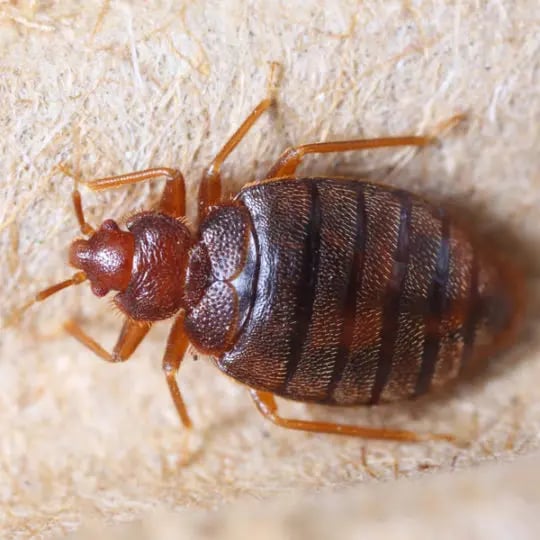Checking Out the Scientific Research Behind Bed Insect Heat Treatments as a Sustainable Parasite Monitoring Approach
One such approach that has gained traction in recent years is the use of warm therapies to deal with bed bug invasions. The intricacies of just how warmth efficiently gets rid of bed bugs and the wider ramifications for lasting insect management practices make this a subject worth discovering better.
Bed Pest Warm Treatment Process

Thermal Death Factor for Bed Insects
Exposing bed insects to elevated temperatures beyond their thermal resistance variety is important for attaining efficient removal in warm therapy processes. The thermal fatality point for bed bugs describes the temperature at which these parasites can not survive. Research suggests that bed pests begin to perish when exposed to temperatures above 113 ° F(45 ° C) for a sustained duration. As the temperature raises, so does the mortality price of bed bugs. At around 118 ° F(48 ° C ), bed insects start to pass away quickly, with a death rate of virtually 99% within mins of exposure. This demonstrates the sensitivity of bed insects to heats and highlights the efficiency of heat therapies in removing invasions. By reaching and maintaining temperature levels above the thermal death factor for bed insects, pest management experts can guarantee detailed elimination of bed bug populations, including hard-to-reach areas where chemical therapies might be much less reliable. Comprehending the thermal fatality factor for bed bugs is vital for carrying out effective warm therapy strategies and accomplishing lasting insect management outcomes.
Benefits of Warm Treatments
Having actually developed the important thermal death point for bed pests, it is critical to currently discover the considerable advantages that warm therapies offer in successfully getting rid of these resilient pests. When compared to standard chemical techniques, warmth therapies present numerous vital benefits. Among the key advantages is that warm can permeate deep right into gaps and cracks where bed pests conceal, making certain that even one of the most hard-to-reach areas are heated to lethal temperatures. This thorough approach not just eliminates live pests yet additionally targets bed pest eggs, avoiding future infestations.
Moreover, warmth therapies are ecologically friendly and safe, making them a lasting bug monitoring technique. Unlike chemical pesticides, warmth therapies do not leave dangerous residues that can present risks to human health or the setting. This aspect is particularly vital in sensitive environments such as healthcare facilities, colleges, and property locations where chemical use may not be desirable.
Additionally, warm treatments have a high success rate in eliminating bed pest infestations in a solitary therapy, minimizing the need for numerous brows through and reducing interruption to passengers. This performance not only saves money and time but additionally supplies satisfaction to those dealing with bed bug troubles.
Effectiveness of Warmth Treatment

Warm therapies have actually the included benefit of eliminating bed insect eggs, which are usually immune to typical chemical treatments. Generally, the effectiveness of warmth treatments in removing bed bug infestations makes them a sustainable and reliable bug monitoring strategy.
Lasting Parasite Monitoring Conveniences
Carrying out sustainable parasite monitoring methods supplies long-term benefits for both the setting and public health and wellness. By making use of techniques such as warm therapies for pest control, we can reduce the reliance on unsafe chemical pesticides that can have damaging effects on communities and human health and wellness - exterminator. Sustainable bug administration techniques help in maintaining biodiversity by targeting particular insects without harming non-target microorganisms, thereby why not find out more maintaining a well balanced environment
Additionally, try this site lasting insect management practices add to the total health and wellness and wellness of the public. By decreasing exposure to poisonous chemicals made use of in standard pest control methods, warmth treatments provide a safer option for insect management in residential, industrial, and public areas. This reduction in chemical usage likewise aids in preventing chemical residues from polluting air, water, and dirt, protecting ecological top quality.
Conclusion
In verdict, bed bug heat treatments have been revealed to be a lasting and reliable bug monitoring technique. The thermal death factor for bed insects makes them at risk to heat therapies, which have numerous benefits over standard chemical therapies. The effectiveness of heat therapies in eliminating bed bug infestations while minimizing ecological impact highlights the potential of this approach as a lasting remedy for parasite control.
The bed insect heat therapy procedure entails elevating the temperature level within plagued areas to a level that successfully eliminates bed pests and their eggs. By getting to and maintaining temperatures over the thermal fatality point for bed bugs, insect administration professionals can ensure thorough removal of bed bug populations, including hard-to-reach areas where chemical therapies might be much less efficient. One of the key advantages is that heat can penetrate deep right into gaps and splits where bed pests hide, guaranteeing that even the most hard-to-reach locations are heated to dangerous temperatures. Unlike chemical treatments that may leave behind immune populations, warm therapies use a ecologically friendly and safe visit homepage service that can permeate deep right into furnishings, wall surfaces, and various other hard-to-reach locations where bed pests hide.
The thermal fatality point for bed insects makes them prone to warm treatments, which have various advantages over typical chemical treatments.